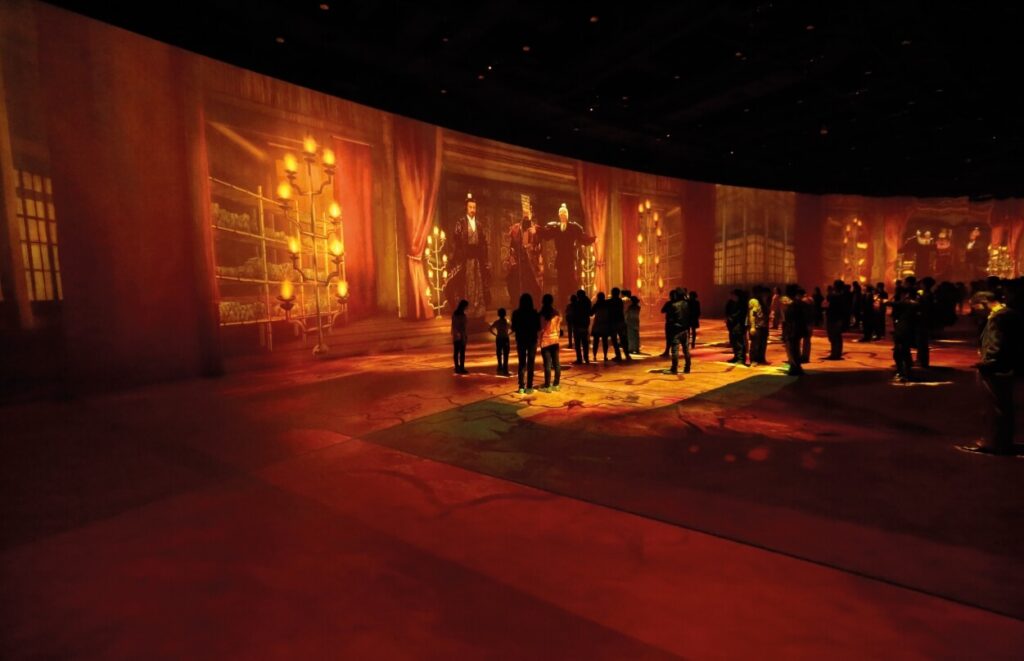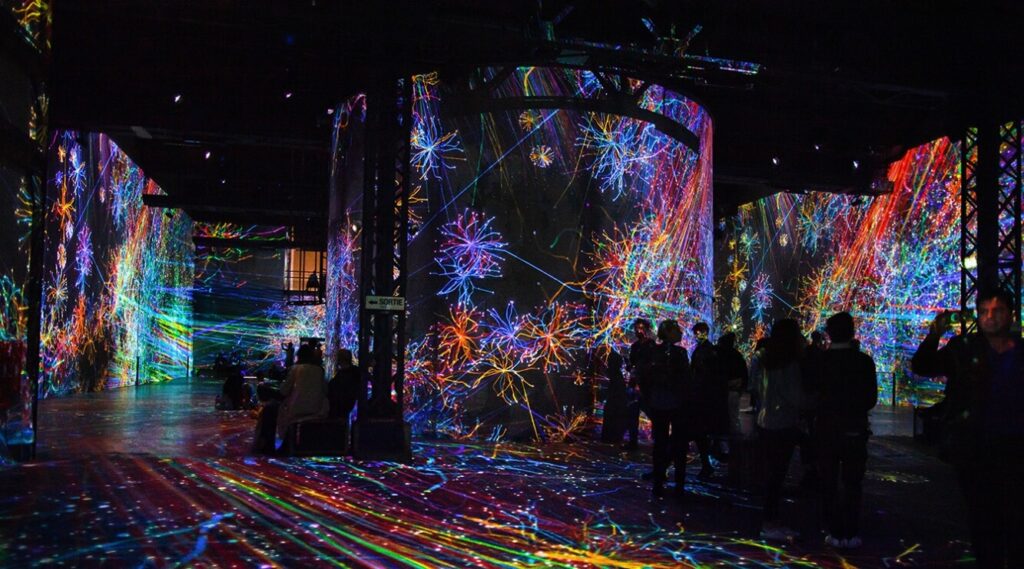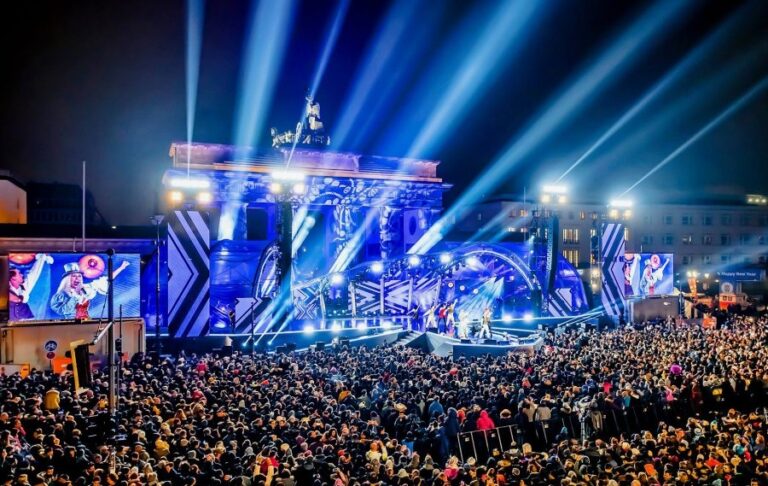Table of Contents
ToggleTable of contents
What is an immersive exhibition?
3 common types of immersive exhibitions
What is the difference between a showroom and a gallery?
What LED displays are used in immersive exhibitions?
How to create an immersive exhibition?
In recent years, the term “immersive” has become very popular. From street restaurants and miniature board games to large performance venues and theme parks with thousands of people, different companies and businesses in all walks of life are emphasizing “immersion” and have added immersive experiences. Terms such as “immersive exhibition hall” and “immersive exhibition hall” have also emerged, and they appear very frequently, becoming an eye-catching exhibition form.

What is an immersive exhibition?
The immersive exhibition hall is a highly immersive virtual demonstration environment composed of three or more projection walls. With three-dimensional technology, visitors can be in a three-dimensional immersive space, giving visitors a shocking effect. An immersive experience.
3 common types of immersive exhibitions
In exhibition hall design, there are three common immersive forms, namely dome theater, BOX environment, and 4K surround. They make the presentation more advanced. The dome theater uses a giant projection screen and uses special technical means to project images in front of the audience, creating an immersive feeling. The biggest advantage of this form is that it can achieve all-round three-dimensional viewing, which can not only meet the needs of family viewing, but also serve as a stage for commercial performances.
Dome theater
The theater has a dome-like structure, and the screen is hemispherical. The audience is surrounded by it. The screen is like the sky, as if they are in an inverted bowl. The surrounding image content and three-dimensional sound effects make the audience feel immersed in the scene. The all-round three-dimensional illusion and strong immersion effect create an unforgettable sensory experience. “We hope that in this way, everyone can feel the charm of art while enjoying the visual feast.
BOX environment
The realization of this type of immersive space uses the box structure as a creative element and combines it with virtual reality technology to achieve realistic, three-dimensional, and even naked-eye 3D visual art effects. In this, the audience can feel the personalized artistic light and shadow, thus giving them the feeling of being in a different dimension. The application of this kind of virtual reality technology not only allows the audience to have a better immersive experience while watching the movie, but also allows the audience to have a deeper understanding of the story behind the movie while enjoying the movie.
4K surround
It is a multimedia interactive projection with a ring, arc or curved surface as the projection screen, which surrounds the audience in the center of the ring screen. With the support of projection fusion technology, the surround stereo sound effect is integrated with the film content. , the audience can enjoy a large, complete and unified image and enjoy a magnificent audio-visual feast. Here, you can enjoy the unparalleled shocking effect brought by the cinema, and you can also experience the feeling of a cinema at home.

What is the difference between a showroom and a gallery?
Feature
The main functions of exhibition halls and galleries are different. The main function of the exhibition hall is to provide display space for various exhibitions, including works in various fields such as art, design, photography, etc. Galleries, on the other hand, focus more on the sale and promotion of art, usually displaying and selling works from various artists.
Display method
There are also differences in the way displays are displayed in showrooms and galleries. Exhibition halls usually arrange the display space according to different exhibition themes, while galleries focus more on displaying artworks in a more aesthetic way.
audience group
The audience group of the exhibition hall is wider, including not only art lovers, but also ordinary viewers who are interested in various exhibitions. The audience of the gallery is more concentrated among art lovers, collectors and investors.
sense of experience
The experience of an exhibition hall may include elements such as multimedia, sound effects, and interactive installations, while a gallery may focus more on a quiet and comfortable atmosphere so that viewers can better appreciate the works.

What LED displays are used in immersive exhibitions?
In immersive exhibition halls, LED displays often play a key role in presenting high-resolution images, videos and information. Here are some common types of LED displays that may be used in immersive showrooms:
Curved LED display: Curved LED display can be customized according to the shape of the exhibition space, creating a seamless visual effect and giving the audience an immersive experience.
LED video wall: LED video wall consists of multiple LED modules, usually mounted on the wall, providing high-resolution and large-scale visual effects. They can be used to display huge images, videos, interactive content or real-time data.
LED floor screen: LED floor screen can be embedded in the exhibition hall floor to provide immersive visual effects on the ground. Viewers can walk on it and interact with the content. Here is a professional guide to LED floor screens.
Transparent LED display: The transparent LED display allows light to pass through, so it can be placed on a glass wall or glass curtain wall, creating a transparent and immersive visual effect.
Flexible LED display: Flexible LED display can be bent according to specific shapes to adapt to various display needs, such as curved walls or circular spaces. Learn about LED flexible screens in 3 minutes.

How to create an immersive exhibition?
Space layout
Spatial layout is the core of exhibition hall design. A reasonable spatial layout can allow exhibitors to naturally enter the exhibition area and visit along the predetermined route. The spatial layout of the exhibition hall should be concise and clear, and try to avoid too many partitions and maze-like layouts. At the same time, the exhibition area should be divided into three basic areas: reception area, exhibition area and communication area. Each area should have its own unique function and atmosphere.
Lighting Design
Lighting design is an integral part of exhibition hall design. A good lighting design can make the exhibition hall more vivid and three-dimensional, allowing exhibitors to experience the charm of the company or product immersively. The lighting design should be designed differently according to different areas. For example, the lighting in the reception area should be bright and soft, and the lighting in the display area should highlight the highlights of the exhibits.
Color matching
Color matching is a crucial part of exhibition hall design. A good color combination can make the exhibition hall more vivid and interesting, and can also highlight the characteristics of the company or product. Color matching should follow the principles of simplicity and grandeur, and try to avoid too many colors and overly complex patterns.
Integrating virtuality and reality
Modern technological means, such as VR, AR, holographic projection, etc., can give visitors a more realistic and in-depth experience in the exhibition hall. For example, a VR experience area can be set up in the exhibition hall so that viewers can have an in-depth understanding of the display content through virtual reality technology.
Digital engagement and personalized experiences
In the immersive experience exhibition hall, visitors can have a deeper understanding of the display content through interactive experiences. For example, you can interact with the display content through touch screen, gesture recognition and other interactive methods, allowing the audience to have a deeper understanding of the display content. Take you 8 minutes to understand the working principle of LED interactive floor tile screen.
Audience experience
In the design of the immersive experience exhibition hall, it is necessary to pay attention to the experience and feelings of the audience. Comfortable rest areas, guide service areas, etc. can be set up to facilitate visitors to visit and understand the display content. At the same time, some interactive experience areas can also be set up so that the audience can have a deeper understanding of the display content.

Summarize
With the rapid development of digital multimedia, high-tech digital interactive creative display projects are increasingly used in exhibition halls. But apart from these digital technical means, more importantly, in the exhibition, we should try our best to achieve true and effective expressions, so that visitors can deeply understand the information to be conveyed and expressed in the exhibition hall, and enjoy an immersive visiting experience. At the same time, we have a deep understanding of the theme and soul of the entire exhibition hall.
Depending on the content, various immersive scenes can be created, with beautiful display effects. When the audience steps into them, they feel as if they are traveling through it, giving people a shocking, stimulating, and sensory-subverting experience. experience. This immersive experience can not only bring visual impact to the audience, but also shock the audience mentally. Moreover, the immersive performance form allows the audience to be immersed in the plot, feel the development of the plot, and resonate with the audience. Therefore, immersive performance is a very good art form.

About Dylan Lian
Marketing Strategic Director at Sostron





